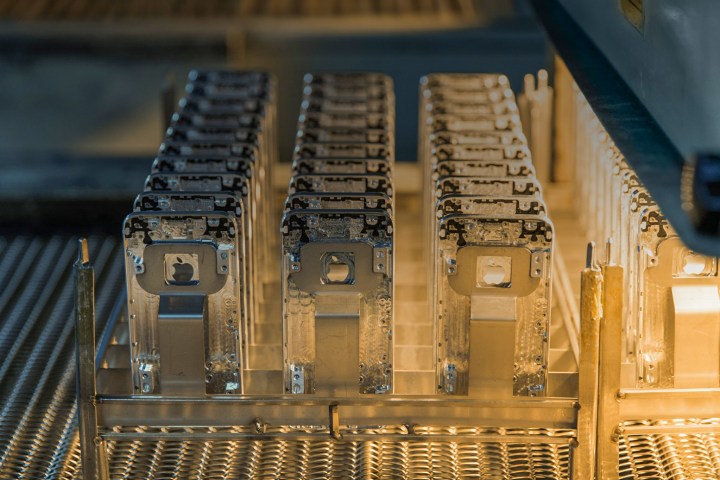
A brand new smartphone is anything but a status symbol. It simply means you’ve been fooled into valuing a shiny new object over its impact on labor, the environment, or even your own time. And it’s not entirely your own fault.
After all, our Twitter streams are filled with comments about Apple’s latest product launch and links to Medium posts and unboxing videos by those delighted or vanquished by their new purchases. It’s hard not to want the button, the two-lens camera, or iris-recognition security. Such innovations make a single lens or thumbprint security feel, well, so last quarter.
Yet the gadgets truly in need of glorification in our Instagram feeds are those battered, bruised, and still-ticking devices that don’t demand their own replacement every 365 days.
Hidden costs
The less-told stories here, and the ones deserving our attention, are the human and climate cost of all these new and unnecessary devices – costs brilliantly externalized by the aesthetic and marketing of tech products.
The lion’s share of processing activity – and energy consumption – is actually occurring on servers.
The Bauhaus elegance of an iPhone, for example, makes it feel as if the device’s primary functions are really occurring inside its new, water-resistant case. The battery is for your screen, and little else. The lion’s share of processing activity – and energy consumption – is actually occurring on servers streaming all those videos and making all the harder calculations and analyses. Siri is not in your phone, she’s on a bunch of HP servers in the cloud. That energy consumption is immense, particularly in comparison with that of recharging our phones every night. Watching an hour of video on your smartphone every week for a year actually uses two refrigerators’ worth of electric power.
And all that electricity only accounts for around 20 percent of the electricity a smart phone will use in its lifetime, once you factor in the energy used for production and distribution of the phone itself. If the phone materials were actually recycled, there would be additional energy costs – but at least those would have been well spent. As it is, most e-waste is just dumped in huge piles in developing nations, forming small mountains of toxic trash on which impoverished families scavenge for sellable parts. E-waste is estimated to reach 60 million tons next year.
Finally, every new smartphone contains several grams of rare earth metals and “conflict” minerals including gold, tin, tungsten, and tantalum. These are mined for, at gunpoint, by child slaves in the Congo. That’s right: Your purchase of a new smartphone requires a kid to go into a cave for minerals, and empowers the people and companies who are exploiting him. (To be fair, most smartphone manufacturers feel really bad about this, and wish they could come up with a way of supplying you with a new phone every year that didn’t depend on raping and killing children.)
Why do you need that phone again?
Companies have an excuse. Corporate activity has almost always depended on slave labor and environmental destruction. Meanwhile, shareholders demand quarter-over-quarter growth from the companies they own – particularly when they’re technology companies. When Apple sells fewer iPhones than it did the year before, the company’s valuation decreases by billions of dollars.
What’s our excuse? Is a wireless headphone port or wraparound screen really worth the social and environmental cost? How many socially conscious tweets would it take to compensate for the damage caused by a single smartphone purchase?
It’s time we technology consumers began demanding something different from our manufacturers: longevity.
No, the only real response – the true techie’s response – is to learn how to make one’s phone last as many years as possible. Instead of buying our way out of obsolescence, we program, adapt, and workaround. What makes a phone great is not how new it is, but how long it lasts.
That’s why the person who wins my admiration at a party or conference is not the guy with the latest model smartphone or laptop, but the woman sporting an iPhone 3 and a 2009 MacBook Pro. And not because she’s a luddite, but because she’s the one with user mojo capable of participating at high efficiency in any essential digital activity with the same technology that less savvy consumers would have to consider obsolete.
I once had a guitar teacher who tried to make me feel better about the fact that all the other kids in the music school had expensive Martins while I had a used no-name. He said that in his experience, people’s ability to play was inversely proportional to the cost of their instruments. Willie Nelson’s guitar – holes and all – is testament to the sort of materialism that values the world’s existing objects more than those that have yet to be sourced and assembled.
What’s old is cool again
It’s time we technology consumers began demanding something different from our manufacturers: longevity. That’s a big ask. Even when our phones don’t wear out, they are nonetheless obsolesced by OS upgrades and network changes that seem designed to do little more than force new hardware purchases. App developers can be wiped out by a single iPhone update, and are often forced to choose between serving those on the “old” OS or those who have moved to the new one.
And the more of us stick with the phones we have, the more pressure we will exert on developers to maintain true backwards compatibility – the same way committed Windows 3.1 users forced Netscape and Internet Explorer to remain compatible with them if they wanted to gain market share in the browser wars of the late ‘90s.
Our numbers matter. If we flocked to the new phones, we support a technology landscape that favors change for change’s sake over stability, ease of use, open development, environmental sustainability, and basic human rights.
Love the phone you’re with.



